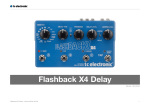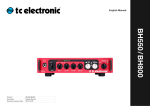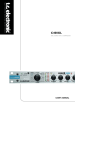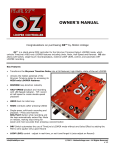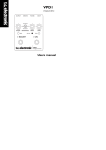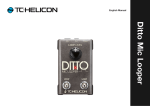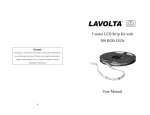Download Ditto Looper in 30 seconds
Transcript
DITTO LOOPER User Manual Table of contents Introduction1 Important safety instructions 2 EMC/EMI3 Unpacking and setting up 4 Ditto Looper in 30 seconds 5 Operation5 Technical Specifications 5 Input, output, controls 6 Power input 6 Audio input 6 Audio output 6 Footswitch6 Loop Level knob 6 USB connector 6 Working with loops 7 Recording your first loop 7 Setting loop playback volume 7 Overdubbing7 Undo (deleting the last take) 7 Redo (restoring a previously deleted take) 7 Using Undo/Redo creatively 8 Stopping loop playback/recording 8 Deleting the loop 8 Storing the loop 8 Setup examples 9 True Bypass and Analog Dry-through 9 FAQ10 a Introduction Introduction “It seems that perfection is attained not when there is nothing more to add, but when there is nothing more to remove.” Antoine de Saint-Exupéry, Terre des Hommes (1939) Congratulations on your purchase of TC Electronic’s amazing Ditto Looper! About this manual What puts Ditto Looper miles ahead of the looper pack is its minimalist, no-nonsense approach to looping. This is not a product that tries to cater to singers, drummers, DJs or experimental Jazz xylophone players.* TC Electronic designed Ditto Looper with guitar and bass players in mind. This manual will provide you with a quick overview of how to get rocking fast as well as an in-depth look at the pedal’s more advanced features. Happy reading! The result? A looper that is 100 % intuitive and takes up virtually no space on a pedal board. The latest revision of this manual can be downloaded from http://www.tcelectronic.com/manuals.asp Please note: TC Electronic reserves the rights to change the contents of this manual at any time. This is version 1.0 of the Ditto Looper manual. * Of course, everyone (including experimental Jazz xylophone players…) is more than welcome to use Ditto Looper! If quality and simplicity is your thing, you will enjoy this product. If you still have questions about the product after reading this manual, please get in touch with TC Electronic Support: http://www.tcelectronic.com/support 1 Important safety instructions Important safety instructions –– Read these instructions. Warning –– Keep these instructions. To reduce the risk of fire or electrical shock, do not expose this equipment to dripping or splashing and ensure that no objects filled with liquids, such as vases, are placed on or near the equipment. –– Heed all warnings. –– Follow all instructions. –– Do not use this apparatus near water. –– Clean only with dry cloth. –– Do not block any ventilation openings. Do not install this product in a confined space. –– Install in accordance with the manufacturer’s instructions. Service –– Do not install near heat sources such as radiators, heat registers, stoves, or other apparatus (including amplifiers) that produce heat. Caution –– Only use attachments/accessories specified by the manufacturer. –– Refer all servicing to qualified service personnel. Servicing is required when the apparatus has been damaged in any way, such as power supply cord or plug is damaged, liquid has been spilled or objects have fallen into the apparatus, the apparatus has been exposed to rain or moisture, does not operate normally, or has been dropped. All service must be performed by qualified personnel. You are cautioned that any change or modifications not expressly approved in this manual could void your authority to operate this equipment. 2 EMC / EMI Electromagnetic compatibility (EMC) Electromagnetic interference (EMI) For customers in Canada This equipment has been tested and found to comply with the limits for a Class B Digital device, pursuant to part 15 of the FCC rules. This Class B digital apparatus complies with Canadian ICES-003. These limits are designed to provide reasonable protection against harmful interference in residential installations. This equipment generates, uses and can radiate radio frequency energy and, if not installed and used in accordance with the instructions, may cause harmful interference to radio communications. However, there is no guarantee that interference will not occur in a particular installation. If this equipment does cause harmful interference to radio or television reception, which can be determined by turning the equipment off and on, the user is encouraged to try to correct the interference by one or more of the following measures: Cet appareil numérique de la classe B est conforme à la norme NMB-003 du Canada. –– Reorient or relocate the receiving antenna. –– Increase the separation between the equipment and receiver. –– Connect the equipment into an outlet on a circuit different from that to which the receiver is connected. –– Consult the dealer or an experienced radio/TV technician for help. 3 Unpacking and setting up Unpacking and setting up Ready… Set… The Ditto Looper box should contain the following items: –– 1 Ditto Looper pedal Connect a 9V power supply with the following symbol to the DC input socket of Ditto Looper: –– 1 Ditto Looper quick guide –– 2 rubber feet for “non-velcro” pedal board mounting –– 1 TC Electronic sticker –– Plug the power supply into a power outlet. –– 1 leaflet about TC’s guitar FX product range. Inspect all items for signs of transit damage. In the unlikely event of transit damage, inform the carrier and supplier. –– Connect your instrument to the INPUT jack on the right side of the pedal using a ¼” cable. If damage has occurred, keep all packaging as it can be used as evidence of excessive handling force. –– Connect the OUTPUT jack on the left side of the pedal to your amplifier. Ditto Looper does not come with a power supply. Please note that Ditto Looper has no battery compartment, and you cannot connect a USB power supply to the USB port. A conventional power supply is required for operating this product. Play! 4 Ditto Looper in 30 seconds Ditto Looper in 30 seconds If you are in a hurry, chances are you’ll find what you’re looking for on this page. Operation Technical Specifications Power up Ditto Looper Connect a power supply. Record Tap footswitch once. Switch to playback Tap footswitch again. Undo/Redo last recording Press and hold footswitch. Stop Double-tap footswitch. Stop and delete the loop Double-tap and hold footswitch. Resume playback Tap footswitch again. Delete the loop Press and hold footswitch (when Ditto Looper is disengaged). Maximum loop length Maximum no. of overdubs Bypass mode Latency Dimensions (Width x Depth x Height) Input Connector Type Output Connector Type Power Input USB Connector Type Controls 5 minutes Unlimited True Bypass None (analog dry-through) 48 x 48 x 93 mm / 1.9 x 1.9 x 3.7” Standard ¼” jack – mono/TS Standard ¼” jack – mono/TS Standard 9 V DC, centre negative (not supplied) Mini-B USB Loop Level knob (Loop playback volume) Switch (Loop playback control) 5 Input, output, controls Input, output, controls 2 – Audio input This is a standard ¼” input jack (mono/TS). Connect your guitar here using a regular ¼” mono cable. 5 For other setups, see the “Setup examples” section of this manual. 6 1 3 3 – Audio output This is a standard ¼” output jack (mono/TS). Connect this jack to your amplifier using a regular ¼” mono cable. 2 4 For other setups, see the “Setup examples” section of this manual. 4 – Footswitch Use this footswitch to control all loop-related functions of the pedal (record, playback, undo/redo, delete). See the following section of this manual (“Working with loops”). 1 – Power input This is a standard 5.5/2.1 mm DC plug (centre = negative). To power up Ditto Looper, connect a power supply to its power input socket. Ditto Looper requires a 9 V power supply providing 100 mA or more (not supplied). To minimize hum, use a power supply with isolated outputs. 5 – Loop Level knob Use this knob to control the level of your loops. (You didn’t see this one coming, did you?) 6 – USB connector This is a USB Mini-B type socket. It can be used to transfer software updates to this product from a computer. 6 Working with loops: Recording / Overdubbing / Undo & Redo Working with loops Overdubbing Recording your first loop –– To record another take (overdub), press the footswitch again while the original loop is playing back. The LED will turn red, indicating you’re in Record mode again. –– To start recording, press the footswitch once. The LED will light up in red, indicating Ditto Looper is in Record Mode. –– At the end of the loop (eg after eight bars), press the footswitch again. The LED will turn green, and Ditto Looper will repeat the loop continuously. The LED will blink every time Ditto Looper reaches the starting point of the loop. Your loop can be up to five minutes long! Setting loop playback volume –– To change the playback volume of the loop you just recorded, adjust the knob labelled “Loop Level”. The Loop Level knob only controls loop playback level – it has no influence on the signal from your instrument. When you’re happy with your loop, you can start overdubbing. –– When you’re done, press the footswitch once more to quit Record mode. Ditto Looper will repeat the loop with both the original recording and the overdub. Please note that the length of the loop will never increase when overdubbing. When you continue playing, you will simply create additional overdubs. You can record as many overdubs as you like – there is no limit. Undo (deleting the last take) –– To undo (delete) the last take you recorded, simply press and hold the footswitch for 1.5 seconds or longer. The LED will blink twice in rapid succession, and the last take will be deleted. Redo (restoring a previously deleted take) –– If you have deleted the last take and you changed your mind, you can restore that take. To do so, simply press and hold the footswitch for 1.5 seconds or longer. The LED will blink twice in rapid succession, and the previously deleted take will be restored. 7 Working with loops: Undo & Redo / Stopping / Deleting loops Using Undo/Redo creatively Undoing and redoing overdubs can be used for more than just correcting mistakes. You can make your performance more interesting by removing and bringing back sections. Here is a simple example: –– Record a bass line (loop cycle 1). Stopping loop playback/recording and deleting the loop –– To stop loop playback/recording and delete everything you have recorded, press the footswitch twice in short succession and hold down your foot on the second tap. –– Record some chords (loop cycle 2). –– Record a melody (loop cycle 3). The LED will turn off to indicate that the loop has been deleted. At this point, you can start recording loops from scratch again. –– Press and hold the footswitch to remove the melody. Improvise or record something else. Deleting the loop when you are not recording or playing back –– Press and hold the footswitch again to bring back the previously recorded melody. –– To delete everything you have recorded, press the footswitch twice in short succession and hold down your foot on the second tap. Please note that undoing or redoing by using the footswitch is only possible during playback. Holding down the footswitch after stopping loop playback/recording will delete the loop! Stopping loop playback/recording –– To stop loop playback or recording, press the footswitch twice in short succession. The LED will start flashing in green to indicate that your loop is still in memory and ready for playback. The LED will turn off to indicate that the loop has been deleted. When you delete your loop from Ditto Looper, the device goes into True Bypass mode. Storing the current loop When you power down Ditto Looper and a loop is in memory, it will be stored automatically. When you power up Ditto Looper again, the LED will flash in green, indicating your previously recorded loop is available. Just hit the footswitch, and playback will start. If you want to start from scratch, delete the loop as described in the previous paragraph. 8 Setup examples Setup examples Amp input Drive pedals FX loop send Amp input FX loop return Modulation pedals Setup example 1: Basic looping – no effects Setup example 3: Ditto Looper in an FX loop If you are using an amp equipped with an FX Loop, place your modulation effects and Ditto Looper in that FX loop. Amp input Drive pedals Modulation pedals Setup example 2: Ditto Looper and effects Place your effects before Ditto Looper. This will allow you to create and record different sounds within the same looping session. The sound of silence: True Bypass and Analog Dry-through Here at TC, we have a simply philosophy: When you are using one of our products, you should hear something great – and if you don’t, you shouldn’t hear it at all. This is why this pedal sports True Bypass. When it is bypassed, it is really off and has zero influence on your tone, resulting in optimum clarity and zero loss of high-end. Also please note that Ditto Looper lets your dry, unprocessed sound pass without ever converting it to digital, keeping your original tone pure and without any latency. 9 FAQ FAQ “Where should I place Ditto Looper in my effects chain?” To get the most out of your setup and the loops you’re recording, place Ditto Looper at the end of your signal chain. This gives you the flexibility to add parts with or without signal processing, switching effects on and off as required. For more information, check out the “Setup examples” section. “What’s the maximum number of overdubs that I can record?” Our guess is that you’ll tire out before Ditto Looper does. Ditto Looper allows an unlimited number of overdubs – so do your worst! “Does Ditto Looper support TonePrints?” No. TonePrints are all about capturing the essence of your favorite guitar player’s effects. Since Ditto Looper records what you play and repeats it, there aren’t really any effects to capture – hence no TonePrints. “How do I get my Ditto Looper to play drums?” You can’t. There is no built-in metronome, drum machine or quantization. We’re keeping things simple! “I made a mistake – how do I undo a part?” Press and hold the footswitch on Ditto Looper while it is playing back your recorded loop. The last part you recorded will be removed. “I changed my mind! How do I restore the part I just removed using the undo feature?” Press and hold the footswitch on Ditto Looper while it is playing back your recorded loop. The part you previously undid will be restored. “How much loop time can I get out of Ditto Looper?” Ditto Looper provides five minutes of looping time. “Why is Ditto Looper’s LED blinking?” When looping, the LED will blink every time it reaches the starting point of your loop. If Ditto Looper is bypassed, but a loop has been recorded, the LED will blink in green to indicate that a loop is stored in Ditto Looper’s memory. If you have more questions about this product, please get in touch with TC Electronic Support: http://www.tcelectronic.com/support 10













